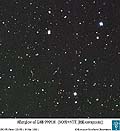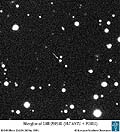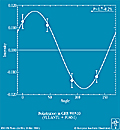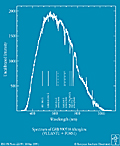Information from the European
Southern Observatory
ESO Press Release
08/99
18 May 1999
For immediate release |
|
Southern Fireworks above
ESO Telescopes
New Insights from
Observations of Mysterious Gamma-Ray Burst
International teams of astronomers are now busy
working on new and exciting data obtained during
the last week with telescopes at the European Southern
Observatory (ESO) .
Their object of study is the remnant of a
mysterious cosmic explosion far out in space,
first detected as a gigantic outburst of gamma
rays on May 10. Gamma-Ray Bursters
(GRBs) are brief flashes of very energetic
radiation - they represent by far the most
powerful type of explosion known in the Universe
and their afterglow in optical light can be 10
million times brighter than the brightest
supernovae [1].
The May 10 event ranks among the brightest one
hundred of the over 2500 GRB's detected in the
last decade.
The new observations include detailed images
and spectra from the VLT 8.2-m ANTU (UT1)
telescope at Paranal, obtained at short notice
during a special Target of Opportunity
programme. This happened just over one month after
that powerful telescope entered into regular
service and demonstrates its great potential for
exciting science. In particular, in an
observational first, the VLT measured linear
polarization of the light from the optical
counterpart, indicating for the first time that synchrotron radiation is involved
. It also determined a staggering distance of more
than 7,000 million light-years to
this GRB .
The astronomers are optimistic that the
extensive observations will help them to better
understand the true nature of such a dramatic
event and thus to bring them nearer to the
solution of one of the greatest riddles of modern
astrophysics.
A prime example of
international collaboration
The present story is about important new
results at the front-line of current research. At
the same time, it is also a fine illustration of a
successful collaboration among several
international teams of astronomers and the very
effective way modern science functions.
It began on May 10, at 08:49 hrs Universal Time
(UT), when the Burst
And Transient Source Experiment (BATSE)
onboard NASA's Compton
Gamma-Ray Observatory (CGRO) high in orbit
around the Earth, suddenly registered an intense
burst of gamma-ray radiation from a direction less
than 10° from the celestial south pole.
Independently, the Gamma-Ray Burst Monitor
(GRBM) on board the Italian-Dutch BeppoSAX satellite also detected
the event (see GCN GRB Observation Report 304
[2]).
Following the BATSE alert, the BeppoSAX Wide-Field
Cameras (WFC) quickly localized the sky position
of the burst within a circle of 3 arcmin radius in
the southern constellation Chamaeleon. It was also
detected by other satellites, including the
ESA/NASA Ulysses spacecraft , since some
years in a wide orbit around the Sun.
The event was designated GRB
990510 and the measured position was
immediately distributed by BeppoSAX Mission
Scientist Luigi Piro to a network of
astronomers. It was also published on Circular
No. 7160 of the International Astronomical
Union (IAU).
From Amsterdam (The Netherlands), Paul
Vreeswijk, Titus Galama, and Evert Rol
of the Amsterdam/Huntsville GRB follow-up
team (led by Jan van Paradijs)
immediately contacted astronomers at the 1-meter
telescope of the South
African Astronomical Observatory (SAAO)
(Sutherland, South Africa) of the PLANET network microlensing
team, an international network led by Penny
Sackett in Groningen (The Netherlands). There,
John Menzies of SAAO and Karen
Pollard (University of Canterbury, New
Zealand) were about to begin the last of their 14
nights of observations, part of a continuous
world-wide monitoring program looking for evidence
of planets around other stars. Other PLANET sites
in Australia and Tasmania where it was still
nighttime were unfortunately clouded out (some
observations were in fact made that night at the
Mount Stromlo observatory in Australia, but they
were only announced one day later).
As soon as possible - immediately after sundown
and less than 9 hours after the initial burst was
recorded - the PLANET observers turned their
telescope and quickly obtained a series of CCD
images in visual light of the sky region where the
gamma-ray burst was detected, then shipped them
off electronically to their Dutch colleagues [3].
Comparing the new photos with earlier ones in the
digital sky archive, Vreeswijk, Galama and Rol
almost immediately discovered a new, relatively
bright visual source in the region of the
gamma-ray burst, which they proposed as the
optical counterpart of the burst, cf. their
dedicated webpage at http://www.astro.uva.nl/~titus/grb990510
.
The team then placed a message on the
international Gamma-Ray Burster web-noteboard (GCN Circular 310), thereby
alerting their colleagues all over the world. One
hour later, the narrow-field instruments on
BeppoSax identified a new X-Ray source at the same
location (GCN Circular 311), thus
confirming the optical identification.
All in all, a remarkable synergy of human and
satellite resources!
Observations of GRB 990510
at ESO
Vreeswijk, Galama and Rol, in collaboration
with Nicola Masetti, Eliana Palazzi and
Elena Pian of the BeppoSAX GRB optical
follow-up team (led by Filippo Frontera)
and the Huntsville optical follow-up team (led by
Chryssa Kouveliotou), also contacted the
European Southern Observatory (ESO). Astronomers
at this Organization's observatories in Chile were
quick to exploit this opportunity and crucial data
were soon obtained with several of the main
telescopes at La Silla and Paranal, less than 14
hours after the first detection of this event by
the satellite.
|

ESO PR Photo
22a/99
[Preview
- JPEG: 211 x 400 pix - 72k]
[Normal
- JPEG: 422 x 800 pix - 212k]
[High-Res
- JPEG: 1582 x 3000 pix - 2.6M] |

ESO PR Photo
22b/99
[Preview
- JPEG: 400 x 437 pix - 297k]
[Normal
- JPEG: 800 x 873 pix - 1.1M]
[High-Res
- JPEG: 2300 x 2509 pix - 5.9M]
|
| |
|
Caption to PR Photo
22a/99 : This wide-field photo was obtained
with the Wide-Field Imager (WFI) at the MPG/ESO
2.2-m telescope at La Silla on May 11, 1999, at
08:42 UT, under inferior observing conditions
(seeing = 1.9 arcsec). The exposure time was 450
sec in a B(lue) filter. The optical image of the
afterglow of GRB 990510 is indicated with an
arrow in the upper part of the field that
measures about 8 x 16 arcmin2. The
original scale is 0.24 pix/arcsec and there are
2k x 4k pixels in the original frame. North is
up and East is left.
Caption to PR Photo
22b/99 : This is a (false-)colour composite
of the area around the optical image of the
afterglow of GRB 990510, based on three
near-infrared exposures with the SOFI multi-mode
instrument at the 3.6-m ESO New Technology
Telescope (NTT) at La Silla, obtained on May 10,
1999, between 23:15 and 23:45 UT. The exposure
times were 10 min each in the J- (1.2 µm; here
rendered in blue), H- (1.6 µm; green) and
K-bands (2.2 µm; red); the image quality is
excellent (0.6 arcsec). The field measures about
5 x 5 arcmin2; the original pixel
size is 0.29 arcsec. North is up and East is
left. |
|

ESO PR Photo
22c/99
[Preview
- JPEG: 400 x 235 pix - 81k]
[Normal
- JPEG: 800 x 469 pix - 244k]
[High-Res
- JPEG: 2732 x 1603 pix - 2.6M] |

ESO PR Photo
22d/99
[Preview
- JPEG: 400 x 441 pix - 154k]
[Normal
- JPEG: 800 x 887 pix - 561k]
[High-Res
- JPEG: 2300 x 2537 pix - 2.3M]
|
| |
|
Caption to PR Photo
22c/99 : To the left is a reproduction of a
short (30 sec) centering exposure in the V-band
(green-yellow light), obtained with VLT ANTU and
the multi-mode FORS1 instrument on May 11, 1999,
at 03:48 UT under mediocre observing conditions
(image quality 1.0 arcsec).The optical image of
the afterglow of GRB 990510 is easily seen in
the box, by comparison with an exposure of the
same sky field before the explosion, made with
the ESO Schmidt Telescope in 1986 (right).The
exposure time was 120 min on IIIa-F emulsion
behind a R(ed) filter. The field shown measures
about 6.2 x 6.2 arcmin2. North is up
and East is left.
Caption to PR Photo
22d/99 : Enlargement from the 30 sec
V-exposure by the VLT, shown in Photo 22c/99.
The field is about 1.9 x 1.9 arcmin2.
North is up and East is left.
|
The data from Chile were sent to Europe where,
by quick comparison of images from the Wide-Field
Imager (WFI) at the MPG/ESO 2.2-m telescope at La
Silla with those from SAAO, the Dutch and Italian
astronomers found that the brightness of the
suspected optical counterpart was fading rapidly;
this was a clear sign that the identification was
correct (GCN Circular 313).
With the precise sky position of GRB 990510 now
available, the ESO observers at the VLT were
informed and, setting other programmes aside under
the Target of Opportunity scheme, were then
able to obtain polarimetric data as well as a very
detailed spectrum of the optical counterpart.
Comprehensive early observations of this object
were also made at La Silla with the ESO 3.6-m
telescope (CCD images in the UBVRI-bands from the
ultraviolet to the near-infrared part of the
spectrum) and the ESO 3.6-m New Technology
Telescope (with the SOFI multimode instrument in
the infrared JHK-bands). A series of optical
images in the BVRI-bands was secured with the
Danish 1.5-m telescope, documenting the rapid
fading of the object. Observations at longer
wavelengths were made with the 15-m Swedish-ESO
Submillimetre Telescope (SEST).
All of the involved astronomers concur that a
fantastic amount of observations has been
obtained. They are still busy analyzing the data,
and are confident that much will be learned from
this particular burst.
The VLT scores a first:
Measurement of GRB polarization
|

ESO PR Photo
22e/99
[Preview
- JPEG: 400 x 434 pix - 92k]
[Normal
- JPEG: 800 x 867 pix - 228k] |
Caption to PR Photo
22e/99 : Preliminary polarization
measurement of the optical image of the
afterglow of GRB 990510, as observed with the
VLT 8.2-m ANTU telescope and the multi-mode
FORS1 instrument. The abscissa represents the
measurement angle; the ordinate the
corresponding intensity. The sinusoidal curve
shows the best fit to the data points (with
error bars); the resulting degree of
polarization is 1.7 ± 0.2 percent.
|
A group of Italian astronomers led by
Stefano Covino of the Observatory of Brera
in Milan, have observed for the first time
polarization (some degree of alignment of
the electric fields of emitted photons) from the
optical afterglow of a gamma-ray burst, see their
dedicated webpage at http://www.merate.mi.astro.it/~lazzati/GRB990510/
. This yielded a polarization at a
level of 1.7 ± 0.2 percent for the optical
afterglow of GRB 990510, some 18 hours after the
gamma-ray burst event; the magnitude was R = 19.1
at the time of this VLT observation.
Independently, the Dutch astronomers Vreeswijk,
Galama and Rol measured polarization of the order
of 2 percent with another data set from the VLT
ANTU and FORS1 obtained during the same night.
This important result was made possible by the
very large light-gathering power of the 8.2-m
VLT-ANTU mirror and the FORS1 imaging
polarimeter.
Albeit small, the detected degree of
polarization is highly significant; it is also one
of the most precise measurements of polarization
ever made in an object as faint as this one. Most
importantly, it provides the strongest evidence to
date that the afterglow radiation of gamma-ray
bursts is, at least in part, produced by the synchrotron process , i.e. by
relativistic electrons spiralling in a magnetized
region. This type of process is able to imprint
some linear polarization on the produced
radiation, if the magnetic field is not completely
chaotic.
The spectrum
|

ESO PR Photo
22f/99
[Preview
- JPEG: 400 x 485 pix - 112k]
[Normal
- JPEG: 800 x 969 pix - 288k] |
Caption to PR Photo
22f/99 : A spectrum of the afterglow of GRB
990510, obtained with VLT ANTU and the
multi-mode FORS1 instrument during the night of
May 10-11, 1999. Some of the redshifted
absorption lines are identified and the stronger
bands from the terrestrial atmosphere are also
indicated. |
A VLT spectrum with the multi-mode FORS1
instrument was obtained a little later and showed
a number of absorption lines ,
e.g. from ionized Aluminium, Chromium and neutral
Magnesium. They do not arise in the optical
counterpart itself - the gas there is so hot and
turbulent that any spectral lines will be
extremely broad and hence extremely difficult to
identify - but from interstellar gas in a galaxy
'hosting' the GRB source, or from intergalactic
clouds along the line of sight. It is possible to
measure the distance to this intervening material
from the redshift of the lines; astronomers
Vreeswijk, Galama and Rol found z = 1.619 ± 0.002 [4].
This allows to establish a lower limit for the
distance of the explosion and also its total
power.
The numbers turn out to be truly enormous. The
burst occurred at an epoch corresponding to about
one half of the present age of the Universe (at a
distance of about 7,000 million
light-years [5]),
and the total energy of the explosion in
gamma-rays must be higher than 1.4
1053 erg , assuming a spherical
emission. This energy corresponds to the entire
optical energy emitted by the Milky Way in more
than 30 years; yet the gamma-ray burst took less
than 100 seconds.
Since the optical afterglows of gamma-ray
bursts are faint, and their flux decays quite
rapidly in time, the combination of large
telescopes and fast response through suitable
observing programs are crucial and, as
demonstrated here, ESO's VLT is ideally suited to
this goal!
The lightcurve
Combining results from a multitude of
telescopes has provided most useful information.
Interestingly, a "break" was observed in
the light curve (the way the light of the
optical counterpart fades) of the afterglow. Some
1.5 - 2 days after the explosion, the brightness
began to decrease more rapidly; this is well
documented with the CCD images from the
Danish 1.5-m telescope at La Silla and the
corresponding diagrams are available on a
dedicated webpage at http://www.astro.ku.dk/~jens/grb990510/
at the Copenhagen University Observatory.
Complete, regularly updated lightcurves with all
published measurements, also from other
observatories, may be found at another webpage in
Milan at http://www.merate.mi.astro.it/~gabriele/990510/
.
This may happen if the explosion emits
radiation in a beam which is pointed towards the
Earth. Such beams are predicted by some models for
the production of gamma-ray bursts. They are also
favoured by many astronomers, because they can
overcome the fundamental problem that gamma-ray
bursts simply produce too much energy. If the
energy is not emitted equally in all directions
("isotropically"), but rather in a preferred one
along a beam, less energy is needed to produce the
observed phenomenon.
Such a break has been observed before, but this
time it occurred at a very favourable moment, when
the source was still relatively bright so that
high-quality spectroscopic and multi-colour
information could be obtained with the ESO
telescopes. Together, these observations may
provide an answer to the question whether beams
exist in gamma-ray bursts and thus further help us
to understand the as yet unknown cause of these
mysterious explosions.
Latest News
|

ESO PR Photo
22g/99
[Normal
- JPEG: 453 x 585 pix - 304k] |
Caption to PR Photo
22g/99 : V(isual) image of the sky field
around GRB 990510 (here denoted "OT"), as
obtained with the VLT ANTU telescope and FORS1
on May 18 UT during a 20 min exposure in 0.9
arcsec seeing conditions. The reproduction is in
false colours to better show differences in
intensity. North is up and east is left.
|
Further photometric and spectroscopic
observations with the ESO VLT, performed by
Klaus Beuermann, Frederic Hessman and
Klaus Reinsch of the Göttingen group of the
FORS instrument team (Germany), have revealed the
character of some of the objects that are seen
close to the image of the afterglow of GRB 990510
(also referred to as the "Optical Transient" -
OT).
Two objects to the North are cool foreground
stars of spectral types dM0 and about dM3,
respectively; they are located in our Milky Way
Galaxy. The object just to the South of the OT is
probably also a star.
A V(isual)-band image (PR Photo 22g/99) taken
during the night between May 17 and 18 with the
VLT/ANTU telescope and FORS1 now shows the OT at
magnitude V = 24.5, with still no evidence for the
host galaxy that is expected to appear when the
afterglow has faded sufficiently.
Outlook
The great distances (high redshifts) of
Gamma-Ray Bursts, plus the fact that a 9th
magnitude optical flash was seen when another GRB
exploded on January 23 this year, has attracted
the attention of astronomers outside the GRB
field. In fact, GRBs may soon become a very
powerful tool to probe the early universe by
guiding us to regions of very early star formation
and the (proto)-galaxies and (proto)-clusters of
which they are part. They will also allow the
study of the chemical composition of absorbing
clouds at very large distances.
At the end of this year, the NASA satellite
HETE-II will be launched, which is expected
to provide about 50 GRB alerts per year and, most
importantly, accurate localisations in the sky
that will allow very fast follow-up observations,
while the optical counterparts are still quite
bright. It will then be possible to obtain more
spectra, also of extremely distant bursts, and
many new distance determinations can be made,
revealing the distribution of intrinsic brightness
of GRB's (the "luminosity function"). Other types
of observations (e.g. polarimetry, as above) will
also profit, leading to a progressive refinement
of the available data.
Thus there is good hope that astronomers will
soon come closer to identifying the progenitors of
these enormous explosions and to understand what
is really going on. In this process, the huge
light-collecting power of the VLT and the many
other facilities at the ESO observatories will
undoubtedly play an important role.
Notes
[1] Gamma-Ray
Bursts are brief flashes of high-energy
radiation. Satellites in orbit around the Earth
and spacecraft in interplanetary orbits have
detected several thousand such events since they
were first discovered in the late 1960s.
Earlier investigations established that they
were so evenly distributed in the sky that they
must be very distant (and hence very powerful)
outbursts of some kind. Only in 1997 it became
possible to observe the fading "afterglow" of one
of these explosions in visible light, thanks to
accurate positions available from the BeppoSAX
satellite. Soon thereafter, another optical
afterglow was detected; it was located in a faint
galaxy whose distance could be measured. In 1998,
a gamma-ray burst was detected in a galaxy over
8,300 million light-years away.
Even the most exotic ideas proposed for these
explosions, e.g. supergiant stars collapsing to
black holes, black holes merging with neutron
stars or other black holes, and other weird and
wonderful notions have trouble accounting for
explosions with the power of 10,000 million
million suns.
[2] The various reports
issued by astronomers working on this and other
gamma-ray burst events are available as GCN
Circulars on the GRB Coordinates Network
web-noteboard.
[3] See also the Press
Release, issued by SAAO on this occasion.
[4] In astronomy, the
redshift (z) denotes the fraction by which
the lines in the spectrum of an object are shifted
towards longer wavelengths. The observed redshift
of a distant galaxy or intergalactic cloud gives a
direct estimate of the universal expansion (i.e.
the "recession velocity"). The detailed relation
between redshift and distance depends on such
quantities as the Hubble Constant, the average
density of the universe, and the 'cosmological'
Constant. For a standard cosmological model,
redshift z = 1.6 corresponds to a distance
of about 7,000 million light-years.
[5] Assuming a Hubble
Constant H0 = 70 km/s/Mpc, mean density
Omega0 = 0.3 and a Cosmological
Constant Lambda = 0.
How to obtain ESO Press Information
ESO Press Information is made available on the
World-Wide Web (URL:http://www.eso.org/outreach/press-rel/
). ESO Press Photos may be reproduced, if credit
is given to the European Southern Observatory.
| 
